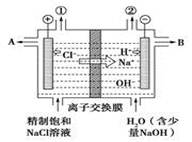问题
选择题
有关阳离子交换膜电解饱和食盐水的(装置如图)说法错误的是

A.转移电子0.8 mol时产生氢气8.96 L(标准状况)
B.从出口B处导出的是氢氧化钠与氯化钠的混合溶液
C.装置中出口①处的物质是氯气,出口②处的物质是氢气
D.装置中的阳离子交换膜只能让阳离子通过,不能让阴离子通过
答案
答案:B
题目分析:A、转移电子0.8 mol时产生氢气的量为0.8÷2×22.4="8.96" L,正确;B、交换膜只能通过阳离子,氯离子不能通过,故出口B导出的是氢氧化钠溶液,错误;C、阳极氯离子失去电子,生成氯气,阴极氢离子得到电子生成氢气,正确;D、正确。
